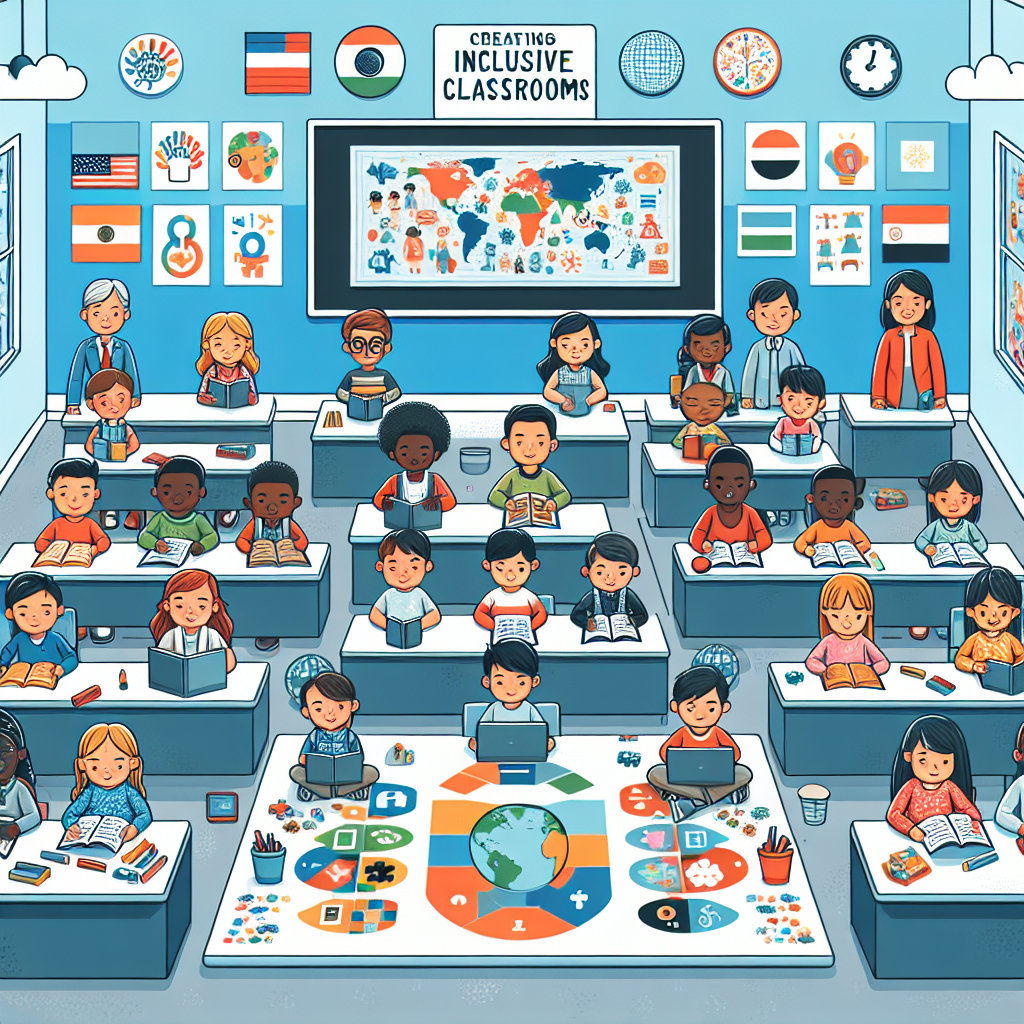
Creating Inclusive Classrooms: Proven Tactics for Addressing Diverse Learner Needs
Introduction
Imagine a classroom where every student feels valued, understood, and empowered to learn at their own pace. A space where diversity is not just acknowledged but celebrated. In today’s global society, creating inclusive classrooms is not merely a noble aspiration; it’s essential. As educators face increasingly diverse populations, the need for successful tactics to address the varied learning needs of students has become critical. The focus on Creating Inclusive Classrooms: Successful Tactics for Addressing Diverse Learner Needs lays the foundation for a nurturing educational environment where each student can thrive.
This article will delve into actionable strategies grounded in real-world case studies, providing educators and stakeholders with valuable insights to foster inclusivity. By the end, you’ll have a toolkit of proven tactics to engage every learner in your classroom.
Understanding Diversity in the Classroom
The Spectrum of Learner Needs
Creating inclusive classrooms begins with recognizing the inherent diversity among students. Diversity can manifest in many ways, including:
- Cultural backgrounds
- Learning abilities and disabilities
- Language proficiency
- Socioeconomic status
Understanding this spectrum is crucial for tailoring educational approaches that meet varied learner needs. For instance, students with learning disabilities may benefit from alternative assessments, while English Language Learners (ELLs) require support in language acquisition.
The Importance of Inclusion
Inclusivity is not just about accommodating different learning styles; it enhances the educational experience for all students. Research has shown that inclusive classrooms lead to:
- Improved academic outcomes
- Enhanced social-emotional skills
- Higher self-esteem among students
- Greater engagement in learning activities
The focus keyword, Creating Inclusive Classrooms: Successful Tactics for Addressing Diverse Learner Needs, encapsulates this profound necessity.
Proven Tactics for Enhancing Inclusion
1. Differentiated Instruction
Differentiated instruction is a hallmark of inclusive classrooms. This approach encourages teachers to tailor their methods based on individual student needs.
Case Study: Oakwood Elementary
At Oakwood Elementary, teachers implemented differentiated instruction by using flexible grouping strategies. For example, during a science unit on ecosystems, students were grouped based on their reading levels. While some students explored texts with rich illustrations, others engaged with more complex scientific articles. The result? An increase in student engagement and improved assessment scores.
Analysis: Oakwood’s success demonstrates how tailored instructional strategies can enhance understanding and participation among diverse learners.
2. Universal Design for Learning (UDL)
Universal Design for Learning promotes a flexible approach to curriculum design. UDL provides multiple means of engagement, representation, and action for learners.
Table 1: UDL Principles
| Principle | Description |
|---|---|
| Multiple Means of Engagement | Address learners’ varying interests and motivation with different activities. |
| Multiple Means of Representation | Present information in various formats (text, audio, visuals) to cater to all learning preferences. |
| Multiple Means of Action & Expression | Offer different ways for students to demonstrate their learning, from projects to presentations. |
By applying UDL, educators can proactively address learner variability, ensuring that all students have access to learning opportunities.
3. Culturally Responsive Teaching
Integrating students’ cultural backgrounds into the curriculum fosters a sense of belonging. Culturally responsive teaching acknowledges the value of students’ experiences and reflects this in lesson planning.
Case Study: River Valley High School
At River Valley High School, educators developed a multicultural curriculum that includes literature from various ethnic backgrounds. This helped ELLs connect with their learning and feel appreciated for their heritage. Through student feedback, the school noted a significant increase in classroom discussions and collaboration.
Analysis: The success at River Valley highlights how valuing cultural backgrounds can enhance learner engagement and foster inclusivity.
4. Implementing Assistive Technologies
Technology plays an integral role in supporting diverse learners. Tools such as speech-to-text software and interactive learning platforms can bridge gaps and facilitate unique learning experiences.
Data Chart: Use of Assistive Technologies in Classrooms
| Technology | Purpose | Impact |
|---|---|---|
| Speech-to-Text Software | Assists students with writing | Improved writing scores |
| Interactive Learning Platforms | Engages students through gamification | Increased motivation and participation |
| Text-to-Speech Tools | Enhances reading accessibility | Boosted comprehension |
The data confirms that integrating assistive technologies has a positive influence on the learning outcomes of students with varied needs.
Cultivating a Supportive Classroom Environment
5. Building Relationships
Forming meaningful relationships with students strengthens classroom dynamics. Spend time getting to know each student’s interests, strengths, and challenges to create a personalized learning environment.
- Positive Reinforcement: Offer verbal praise and rewards for progress, no matter how small.
- Active Listening: Validating students’ thoughts fosters mutual respect and trust.
6. Collaborative Learning
Encouraging collaboration among students promotes inclusivity. Cooperative learning allows learners to engage with peers, leveraging their strengths while developing social skills.
Case Study: Maple Grove School
Maple Grove implemented peer-assisted learning strategies where students partnered to solve math problems. This collaborative effort not only improved math scores but also enhanced student relationships across diverse groups.
Analysis: By facilitating collaboration, Maple Grove demonstrates the effectiveness of intentional peer interaction in fostering an inclusive environment.
Responsive Assessment Methods
7. Alternative Assessments
Traditional assessments can often disadvantage learners who may not excel in standardized formats. Embracing alternative assessments allows students to showcase their knowledge in diverse ways.
Example Methods:
- Projects showcasing creativity
- Oral presentations versus written tests
- Portfolios documenting learning journeys
8. Continuous Feedback
Providing ongoing feedback rather than exclusively at the end of a unit empowers learners to adjust their learning strategies in real-time.
- Formative Assessments: Frequent check-ins to gauge understanding can guide instructional adjustments.
- Student Reflection: Encourage students to reflect on their learning processes and outcomes.
Professional Development for Educators
9. Training and Workshops
Instituting ongoing professional development focusing on inclusive practices is essential. Workshops can offer strategies for differentiation, UDL implementation, and culturally responsive teaching approaches.
10. Building a Collaborative Culture
Creating a school culture that values collaboration among educators encourages the sharing of successful tactics for addressing diverse learner needs.
Analysis: Establishing a community of practice enables educators to learn from one another, share experiences, and collectively explore new ideas.
Conclusion
Creating inclusive classrooms is a multifaceted endeavor that requires commitment, creativity, and a willingness to innovate. By deftly integrating tactics such as differentiated instruction, culturally responsive teaching, and continuous feedback, educators can address the diverse learner needs in their classrooms effectively.
As you embark on this journey of Creating Inclusive Classrooms: Successful Tactics for Addressing Diverse Learner Needs, remember that change begins with small steps. Each effort, no matter how minor it may seem, contributes to building an environment where all learners feel valued and empowered.
FAQs Section
1. What is an inclusive classroom?
An inclusive classroom is one that accommodates all students, regardless of their backgrounds, abilities, or learning styles, promoting a sense of belonging and allowing every student to participate in learning.
2. How can I differentiate instruction effectively?
Differentiating instruction involves adjusting content, process, and product based on learner needs. Use varied teaching strategies, group work, and flexible assessment methods.
3. What role does technology play in inclusivity?
Technology can support diverse learners by providing adaptive resources, enhancing engagement through interactive platforms, and enabling alternative methods for displaying knowledge.
4. How can I encourage collaboration among students?
Set up group projects, establish peer mentoring, and create structured activities that foster teamwork while leveraging individual strengths.
5. What are some signs of a successful inclusive classroom?
Indicators of a successful inclusive classroom include high engagement levels, effective communication among students, and improved academic outcomes across diverse groups.
6. How should I handle conflicts in an inclusive setting?
Address conflicts promptly with empathy, facilitate open dialogue, and promote restorative practices that reinforce community and understanding among students.
By implementing these tactics, educators can make meaningful progress toward Creating Inclusive Classrooms: Successful Tactics for Addressing Diverse Learner Needs, ultimately fostering a richer and more equitable educational landscape.













